The Secret Life of Concealed AC Units: Cool Comforts of Interior Design
- Journalising Designers
- Jul 16, 2025
- 4 min read
When it comes to creating a harmonious and stylish interior, every detail counts. One often overlooked yet essential component in a home’s design is the air conditioning system. While traditional units can be unsightly and disrupt the flow of a room’s aesthetic, concealed AC units offer a seamless solution that blends functionality with style. In this post, we’ll explore the benefits, design options, and overall impact of concealed AC units in modern interior design.
What Are Concealed AC Units?
Concealed air conditioning units are systems that are hidden away from sight, typically installed within walls, ceilings, or floors. Unlike conventional window or split units, these innovative systems prioritize aesthetics without compromising air quality or temperature.
They work silently, ensuring that your space remains serene while providing optimal comfort. This makes them an increasingly popular choice for homeowners and designers seeking a streamlined look paired with efficient climate control.
Benefits of Concealed AC Units
Improved Aesthetics
One of the most appealing aspects of concealed AC units is their discreet nature. By integrating them into your home’s design, you can maintain a polished and cohesive look without the visual clutter that traditional units tend to introduce.
This design choice allows for greater creativity in room layouts and furnishings, ensuring that every piece contributes to an inviting atmosphere.

Enhanced Comfort
Concealed AC units are designed to offer better air distribution compared to traditional units. Instead of blowing cold air directly at a single point, these systems ensure an even distribution of temperature throughout the room.
This results in a more comfortable living environment where hot or cold spots are minimized, allowing you to stay cool and cozy all year round.
Reduced Noise Levels
The silent operation of concealed AC units is another significant advantage. Traditional AC units can generate noise that disrupts conversations, movie nights, and relaxing moments.
In contrast, concealed systems are often placed strategically in less noticeable areas, reducing the sound level and providing a quieter experience within your living space.
Design Options for Concealed AC Units
Integration into Architectural Elements
Many homeowners opt to integrate concealed AC units into their ceilings or walls, using architectural features like coves or custom cabinetry to hide them effectively.
This not only conceals the system but can also add character to a room, making the air conditioning system feel like an intentional part of the design.
Utilizing Vents and Grills
Vents and grills can also be designed to match a room’s decor, resembling decorative elements rather than functional components.
Choosing elegant covers or custom designs can further enhance the aesthetic while providing optimal airflow.
The Role of Smart Technology
Incorporating smart technology within concealed AC systems is another trend gaining popularity. With the rise of smart homes, many concealed AC units now have the ability to connect to smartphone apps or home automation systems.
This allows homeowners to control their indoor climate with ease, ensuring maximum comfort and convenience.
Practical Considerations When Choosing Concealed AC Units
Cost Implications
While the aesthetic benefits of concealed AC units are undeniable, it’s essential to consider the costs associated with installation.
Typically more expensive than traditional units, the investment might pay off with increased property value and energy efficiency in the long run.
Professional Installation is Key
To ensure that your concealed AC unit operates seamlessly within your home design, hiring a professional for installation is crucial.
Improper installation can lead to inefficient cooling and increased energy costs, which defeats the purpose of opting for a concealed system in the first place.
Maintenance Requires Access
It's important to remember that even concealed units require maintenance. This means that designers and homeowners should strategize how to access the units for routine servicing, ensuring they remain functional and efficient.
Stylish Examples of Concealed AC Units in Interior Design
Modern Minimalism
In minimalistic designs, concealed AC units are often cleverly concealed within the ceiling, allowing clean lines and open spaces to take center stage.
This approach not only prioritizes function but also emphasizes simplicity, aligning perfectly with minimalist design principles.
Cozy Rustic Spaces
Concealed AC units can also work well in rustic environments by integrating them into wooden beams or custom cabinetry.
This creates a warm and inviting atmosphere, allowing you to enjoy the aesthetics of a log cabin while still benefiting from modern technological advances.

The Future of Interior Design and Air Conditioning
As the world of interior design evolves, concealed AC units are becoming a staple of modern aesthetics. With a focus on comfort, sustainability, and style, these systems are redefining traditional notions of climate control in homes.
Incorporating them into your design not only enhances your living space but also allows for a more thoughtful and intentional approach to air conditioning.
Conclusion
Concealed AC units offer a smart solution for homeowners looking to combine comfort and style in their living spaces. Their ability to maintain a clean aesthetic while providing effective cooling is unmatched in today's design landscape.
As you consider your next home renovation or build project, don't overlook the importance of these hidden gems. By choosing concealed air conditioning, you create an environment that's as beautiful as it is functional, ensuring that you and your guests can enjoy the perfect temperature without sacrificing style.
With the right choices, you can transform your interior into a sanctuary of comfort and elegance, allowing you to relax in your favorite space all year round.
